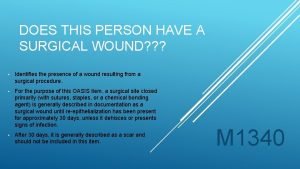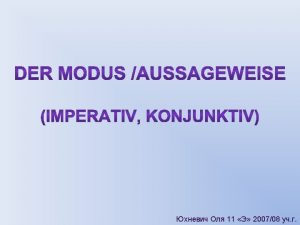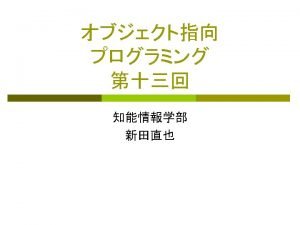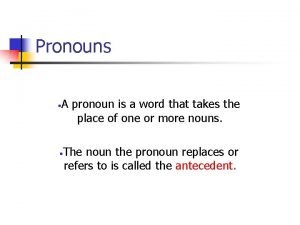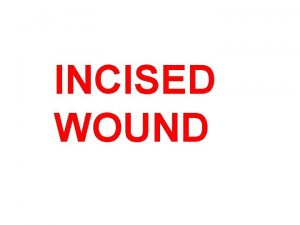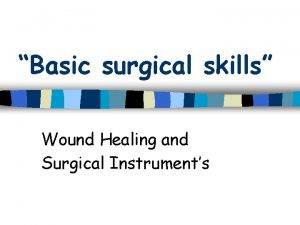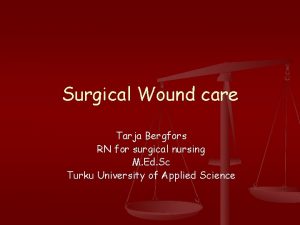DOES THIS PERSON HAVE A SURGICAL WOUND Identifies





- Slides: 5

DOES THIS PERSON HAVE A SURGICAL WOUND? ? ? • Identifies the presence of a wound resulting from a surgical procedure. • For the purpose of this OASIS item, a surgical site closed primarily (with sutures, staples, or a chemical bonding agent) is generally described in documentation as a surgical wound until re-epithelialization has been present for approximately 30 days, unless it dehisces or presents signs of infection. • After 30 days, it is generally described as a scar and should not be included in this item. M 1340

YES • Most surgical incisions • Orthopedic pin sites • I&D with drain • I&D only if there was excision of necrotic mass, abscess, mesh or other appliances or structures (beyond a simple I&D) • • Wound with drain even after drain pulled Have, punch or excisional biopsy • Surgical repair in internal trauma • Take down of ostomy • Pressure ulcer with muscle flap • Dialysis catheter exit site • Implanted infusion devised • ON-Q catheter sites • LVAD exit site • Implanted pumps • Cardiac Cath by cut down • Pacemaker until epithelialized for 30 days • VP shunt • Donor site for grafts • Arthroscopy

NO • I&D with no drain • Debridement • Repair of traumatic laceration • Burn with skin graft • Any wound ending with otomy/ostomy • PICC line (tunneled or nontunneled) • Cardiac Cath by needle procedure • Toenail removal • Pacemaker or internal defibrillator once epithelialized for 30 days • Ostomy allowed to close on its own • Pressure ulcer with skin grafts • Cataract surgery • Pressure ulcer sutured closed • • Arthrocentesis/thoracentesis/par acentesis sites utilized for simple aspiration of fluid Gynecological surgery via vaginal approach • Mucus membranes • Skin graft recipient site

M 1342 : Status of Most problematic (Observable) Surgical Wound STATUS OF HEALING DEFINITIONS APPLY TO SURGICAL WOUNDS HEALING BY PRIMARY INTENTION AND TO THOSE HEALING BY SECONDARY INTENTION. RESPONSE 0: NEWLY EPITHELIALIZED: COMPLETELY COVERED WITH NEW SKIN, NO EXUDATE, NO AVASCULAR TISSUE (ESCHAR AND/OR SLOUGH); NO SIGN OR SYMPTOMS OF INFECTION NOTE: SURGICAL INCISIONS HEALING BY PRIMARY INTENTION DO NOT GRANULATE! BECAUSE OF THIS THE ONLY RESPONSES THE COULD BE APPROPRIATE ARE 0 -NEWLY EPITHELIALIZED OR 3 - NOT HEALING! RESPONSE 1: FULLY GRANULATING: WOUND BED FILLED WITH HEALTHY GRANULATION TISSUE TO THE LEVEL OF THE SURROUNDING SKIN, NO DEAD SPACE, NO AVASCULAR TISSUE, NO SIGN OF INFECTION, EDGES ARE OPEN RESPONSE 2: EARLY/PARTIAL GRANULATION: > OR = 25% OF WOUND BED IS COVERED WITH GRANULATION, THIS IS SOME AVASCULAR TISSUE, NO S/S OF INFECTION, EDGES ARE OPEN. RESPONSE 3: NOT HEALING: >OR = 25% AVASCULAR TISSUE OR S/S OF INFECTION OR CLEAN BUT NONGRANULATING WOUND BED OR CLOSED/HYPERKERATOTIC WOUND EDGES OR PERSISTENT FAILURE TO IMPROVE DESPITE APPROPRIATE WOUND MANAGEMENT.

Misc. stuff • • SCABS • Does not automatically mean non-healing • First determine if the wound is healing by: • Secondary intention (consider all 4 healing status choices. If held open by drains, lines or needle, cannot fully granulate and may remain “nonhealing” while that device is in place. Implanted Venous Access Devices (port-a-cath) • • Primary intention (not healing) Vascular Access Devices • • • When first implanted they are surgical wound. Then follow guidelines of healing. M 1340 Does the patient have a surgical wound? • 0 - No • 1 - Yes, patient has at least one (observable) surgical wound • 2 - Surgical wound known but not observable due to non-removable dressing or device. THE ONLY TIME TO USE THIS ANSWER IF IS THERE IS A PHYSICIAN ORDER TO NOT REMOVE!
